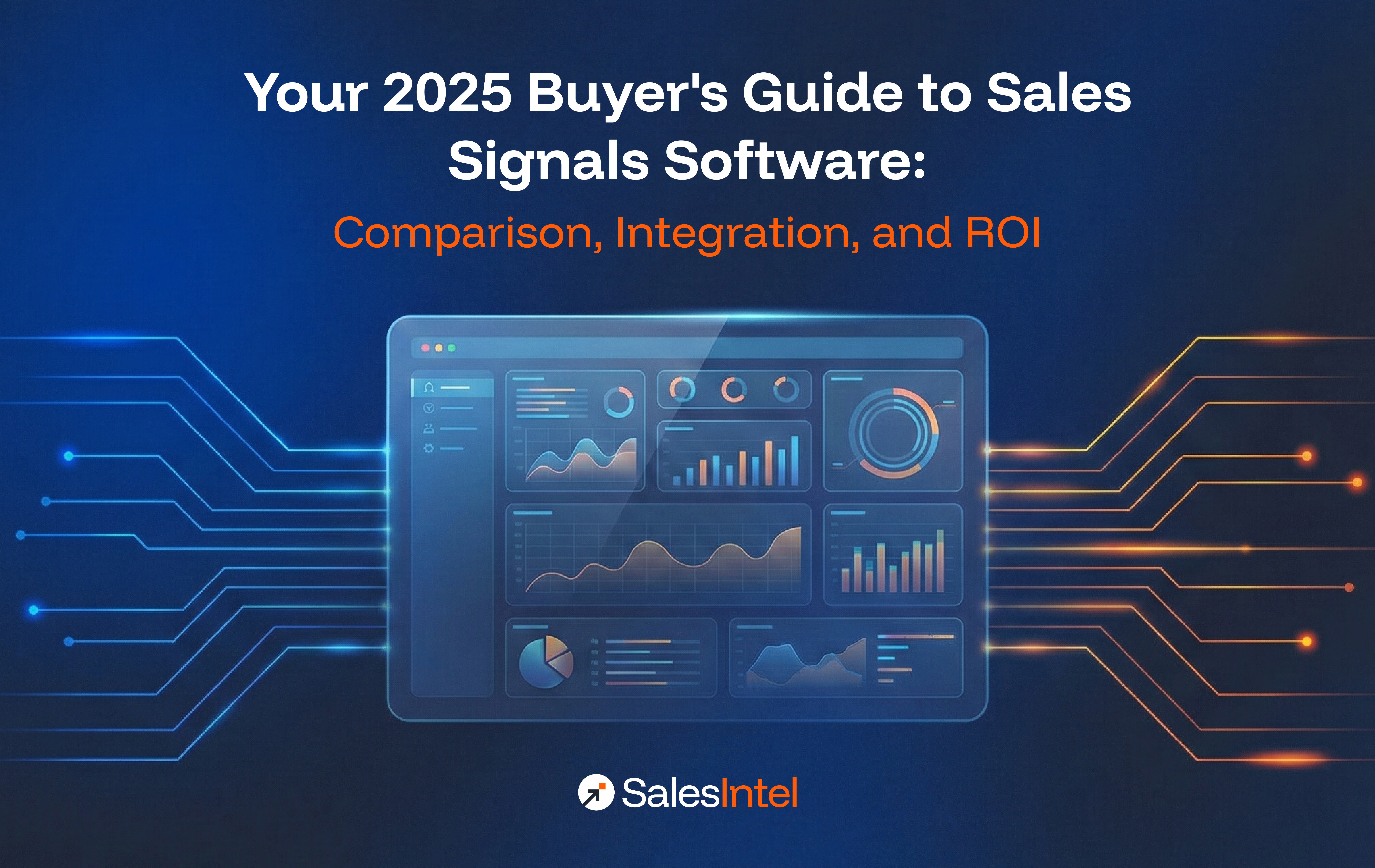Understanding and leveraging marketing data has become essential for success. Marketing data offers valuable insights into customer behavior, campaign performance, and market trends, enabling companies to make informed decisions and craft strategies that drive growth.
In this blog, we’ll discuss the importance of marketing data in B2B SaaS, the most beneficial data types, top data sources, and how to utilize data effectively to create a winning marketing strategy.
The Importance of Marketing Data
If you’re searching for a missing piece in B2B marketing, look no further than data-driven strategies.
Accurate, fresh, and compliant data empowers marketing teams to reach niche audiences, helps sales teams formulate effective sales strategies, and converts leads into loyal customers. The benefits of using data in marketing extend far beyond these basics.
Here are three compelling reasons to equip your marketing team with a data-driven strategy:
Better Understanding of Customers
The mantra “know your customer” has never been more attainable thanks to advances in technology and data analytics. Every interaction with a prospective customer can be tracked and analyzed. Techniques like lead scoring, which assigns value to leads based on their interactions, allow marketers to quickly identify the most promising prospects.
By leveraging data analytics, marketing teams can significantly improve their strategies and outcomes. This powerful tool allows for deeper insights and more informed decision-making, ultimately enhancing nearly every aspect of marketing.
- Campaign Marketers: Design more effective and high-converting campaigns.
- Content Marketers: Create content that addresses specific pain points of prospects.
- Performance Marketers: Identify which ads resonate most and determine where your audience spends their time online.
- Product Marketers: Discover which product features are most beneficial to customers.
More Effective Campaigns
In SaaS sales, marketing data is instrumental in helping your product or service stand out in a crowded market. By analyzing detailed customer data, you can pinpoint specific user needs and tailor your product offerings accordingly. This approach not only enhances the appeal of your product but also allows for personalized marketing strategies that resonate with your target audience.
- Target Audience: Identify who they are, where they work, and their business objectives.
- Optimal Channels and Timing: Determine the best channels to reach your prospects and the ideal times for engagement.
- Personalized Messaging: Craft messages that address the challenges faced by your audience and demonstrate how your product can solve them.
Optimized Marketing Processes
Time management is a critical challenge for B2B marketing teams. A data-driven approach enhances productivity by focusing on the most impactful tasks. By selecting and tracking key marketing metrics and KPIs, teams can identify which activities yield the best results. This ongoing process of revision and optimization ensures continuous improvement.
Several techniques contribute to optimizing marketing processes:
- A/B Testing: Provides valuable data to refine strategies by comparing different versions of a campaign or webpage.
- Predictive Analytics: Uses historical data to forecast future trends, enabling proactive adjustments to marketing strategies.
- Customer Segmentation: Divide the customer base into distinct groups based on data, allowing for more targeted and effective marketing campaigns.
- Content Personalization: Tailors marketing messages and content to individual customer preferences, increasing engagement and conversion rates.
- Automation Tools: Streamline repetitive tasks, such as email marketing and social media posting, freeing up time for strategic activities.
Understanding and leveraging customer data is crucial for marketing leaders, who must also educate their teams on its importance to ensure success. By employing these data-driven techniques, marketing processes can be continually optimized, leading to improved efficiency and better outcomes.
Integrating a marketing data strategy not only enhances your understanding of customers and improves campaigns but also optimizes your entire marketing process, driving higher efficiency and better results.
What Type of Marketing Data is the Right for Your Business?
Choosing the right B2B data will directly impact the effectiveness of your marketing and sales strategy. The following are the B2B data types that you should consider adding to your database to ensure a more focused approach in your marketing campaigns as well as targeted sales messaging to your prospects and leads.
Firmographic Data
Firmographic data contains important company details that help you categorize accounts (companies) that are suitable for you. Similar to demographics for individuals, firmographics include information such as:
- Company size
- Industry
- Employee size
- Office location(s)
- SIC Code
- Zip Code
With the aid of firmographic data, you can segment your target market by analyzing characteristics such as company size, industry, revenue, and location. This segmentation allows you to recognize key revenue factors and optimal purchasing periods for different types of businesses. For example, understanding that a particular industry typically makes budget decisions in Q4 can help you time your marketing efforts more effectively.
For example, if your product is focused on helping startups scale, you can use firmographic data to find startups to target.
Segmenting a market and defining firmographic attributes have the following benefits:
- Business Insights – Obtain valuable information about your B2B target markets by exploring key questions such as the number of employees in the company, their geographic location, and the overall market value of the business. This information helps in creating detailed profiles of your target audience, allowing for more precise and effective marketing strategies.
- Categorization of Marketing Strategies – Firms may be classified by their industry type. For example, government institutions and educational organizations have different defining characteristics. Government institutions typically have longer procurement cycles, stringent regulatory requirements, and fixed fiscal year budgets. In contrast, educational organizations might have seasonal purchasing patterns aligned with academic calendars, different decision-making processes involving committees, and varied funding sources such as grants or donations. Thus, they may require different marketing tactics to reach and resonate with buyers in these industries.
- Optimizing Marketing Strategies – Sending the right message to the right people at the right time involves leveraging data to understand your audience’s preferences and behaviors. This allows you to tailor your messaging to address their specific needs and deliver it through their preferred channels at the most opportune moments. For example, using analytics to identify peak engagement times can ensure your emails are opened and read, while personalizing content based on past interactions can increase relevance and drive conversions.
- Understanding Trends in Data – Evaluating analytics and reports from segmented audiences helps identify specific data patterns such as customer behavior trends, peak engagement times, and preferred communication channels. For example, you might discover that a certain segment of your audience responds better to email campaigns sent in the morning or that another segment prefers video content over written content. By understanding these patterns, you can tailor your marketing strategies to align with your audience’s preferences, improving the efficiency of your campaigns and ultimately boosting revenue. For instance, targeting high-engagement periods can increase open rates and conversion rates.
Contact Data
In lead generation, contact data is collected internally by a company’s customer relationship management (CRM) system or externally by third-party data providers who aggregate this data from various sources.
Contact data includes:
- Name
- Email Address
- Direct Dials
- Work Mobile Dials
It is always recommended to choose a data partner that offers work mobile dials or direct dials.
The first advantage of having a prospect’s direct line is the increased possibility of engaging with a decision-maker.
Technographic Data
Technographical data contains technologies or tools that are used by the target accounts/companies, such as:
- SAP
- Salesforce
- Marketo
- Technology History
- Google Analytics
- Recently added technologies
By leveraging technographic data, you can better understand the technologies that best complement your product or service. For example, if your product suits Salesforce customers well, you can target high-value clients that use Salesforce and maximize the chances of closing a deal.
Here are some benefits of utilizing technographics in your outbound sales and marketing activities:
- More Informed Sales Conversations – Providing helpful information and understanding of the technology that an organization uses. Sales representatives can use this information to customize conversations and sales pitches.
- More Targeted Prospecting – You must thoroughly understand the customers to effectively target interested prospects. Technographics can strengthen buyer personas by evaluating the prospects’ technological stack.
- Improve Conversion Rates – More targeted prospecting involves identifying and focusing on potential customers who are more likely to be interested in your product or service. By using data and insights to understand your ideal customer profile, you can tailor your outreach efforts to meet their specific needs and preferences. Informed sales conversations leverage this data to address the unique pain points and goals of each prospect, making your pitch more relevant and compelling. This approach leads to stronger leads because you are engaging with prospects who have a higher likelihood of converting, ultimately resulting in higher conversion rates.
By combining technographic and firmographic data along with intent data (explained in the next section), you can ensure that you target the best accounts at the right time. SalesIntel helps ensure that this data is easily accessible, updated, and accurate.
Want to learn how to filter your potential customers based on technographic data?
Intent Data
Intent data analyzes the buying signals of the people within your target accounts. Intent data helps show where the prospect is in the buyer’s journey and whether it is an excellent time to reach out. Both firmographic and technographic data will help you sort accounts, while the intent data will provide you with the actions of the individuals behind these accounts.
Intent details include the following:
- Topics or keywords that your target accounts/contacts are actively researching
- Clicks on ads
- Participation in social media
Intent data providers like SalesIntel offer useful visibility into your target accounts or current B2B database without the burden of collecting this data yourself.
Quantitative Data
Quantitative data provides measurable and numerical information that can be used to quantify variables and understand the extent of certain behaviors or trends. It answers questions like “how many,” “how often,” and “how much,” allowing marketers to analyze statistics and make data-driven decisions. Examples include website traffic numbers, conversion rates, and sales figures. Collected through various analytics tools during the marketing process, this type of data helps you measure the effectiveness of your strategies. Here are some critical quantitative data points:
- Website Clicks: Number of times users click on links on your website.
- Form Completions: The count of forms filled out by visitors, indicating potential leads.
- Event Appearances: Attendance numbers at your marketing events.
- Email Open Rates: Percentage of recipients who open your emails.
- Click-Through Rates: Ratio of users who click on links within your emails.
- Customer Information: Data on your current customers, such as demographics and purchase history.
The scope of quantitative data is vast, and these examples are just the beginning. There are many other metrics you can explore and utilize.
Qualitative Data
Qualitative data offers more profound insights into your prospects’ and customers’ characteristics and behaviors. While harder to collect on a large scale, it provides valuable context and personal touches to your data collection efforts. Examples of qualitative data include:
- Social Media Activity: Engagements and interactions on social media platforms.
- Conversation Notes: Summaries and key points from interactions with prospects or customers.
- Questionnaire Responses: Feedback was collected through surveys and questionnaires.
- Product Feedback: Opinions and reviews on your products or services.
Although often overlooked, qualitative data is a rich source of insights that can give you a competitive edge. It complements quantitative data by adding context and depth, helping you understand not just the numbers but the reasons behind them.
How is Marketing Data Collected?
Marketing data is collected from various sources, providing a comprehensive view of customer behavior and campaign effectiveness. Here are some primary sources:
Website Analytics
Tools like Google Analytics track metrics such as website traffic, user behavior, page views, bounce rates, and conversion rates. These insights help understand how visitors interact with your site.
Social media platforms like Facebook, Twitter, LinkedIn, and Instagram offer analytics that tracks engagement metrics such as likes, shares, comments, and follower growth. Social listening tools can also gather qualitative insights from user interactions and sentiments.
Email Marketing
Email marketing platforms like Omnisend, Mailchimp, HubSpot, and Campaign Monitor provide data on email open rates, click-through rates, bounce rates, and unsubscribe rates. This helps measure the effectiveness of email campaigns and audience engagement.
CRM Systems
CRMs like Salesforce and HubSpot track customer interactions and sales data, offering insights into customer demographics, purchase history, and sales pipeline metrics.
Surveys and Feedback Forms
Direct feedback from customers through surveys, questionnaires, and feedback forms provides qualitative data on customer satisfaction, preferences, and pain points.
Event Tracking
Data from webinars, trade shows, and virtual events, such as registration numbers, attendee engagement, and post-event feedback, help measure the impact of these events on lead generation and brand awareness.
Advertising Platforms
Digital advertising platforms like Google Ads and Facebook Ads provide detailed metrics on ad performance, including impressions, clicks, conversions, and ROI.
E-commerce Platforms
For businesses with online stores, platforms like Shopify, Magento, and WooCommerce provide data on sales, product performance, customer behavior, and inventory management.
Third-Party Data Providers
You can purchase B2B data from third-party B2B data providers to supplement your data. These providers offer insights into market trends, competitor analysis, and consumer behavior.
Customer Support Systems
Data from customer support interactions, such as tickets, chat logs, and call recordings, provide insights into everyday issues and customer service performance.
By leveraging these diverse data sources, marketers can gain a holistic understanding of their audience, optimize their strategies, and drive more effective marketing campaigns
Leveraging Data for a Winning Marketing Strategy
Data-driven marketing enables you to connect with customers on a deeper level and develop highly effective marketing strategies. High-quality digital marketing data guides decision-making and helps track the success of each stage of your plan.
The Power of Intent Data
Intent data is one of the most crucial data types for crafting your marketing strategy. By understanding your clients’ intent, you can effectively anticipate their needs and market to them. This data allows you to refine your plan by working on the areas or messaging that aren’t working. It also helps you create a more personalized and engaging customer experience.
Key Steps to Develop a Data-Driven Marketing Strategy
Calculating Total Addressable Market
Effective marketing starts with knowing your market. Determine the number of potential customers, where they are located, and the revenue they could generate. Analyze your marketing data to calculate your Total Addressable Market (TAM), providing these crucial insights.
Identifying Ideal Customers
Developing an ideal customer profile (ICP) is essential before you create a marketing or sales plan. This profile represents the perfect customer who will benefit most from your product or service. Gather data from your current customers through surveys and feedback forms. Look for common characteristics and compile these insights into an ICP template, which your marketing team can use to target new prospects effectively.
Generating High-Quality Leads
The primary goal of any B2B marketing team is to support the sales team by generating high-quality leads. Start with your ICP and TAM calculations, but also focus on creating content that resonates with your audience and launching timely campaigns. These efforts ensure you attract leads that are more likely to convert.
Aligning Marketing and Sales
For a business to thrive, marketing and sales teams must work together, targeting the same prospects and sharing common goals. Data acts as the glue that binds these departments. Set shared revenue targets, facilitate joint prospecting efforts, and track progress continuously. Consider merging these teams into a single revenue operations team to enhance collaboration further. According to research by SiriusDecisions, companies that have aligned their sales, marketing, and customer success teams into a unified revenue operations structure have seen a 19% faster revenue growth and a 15% increase in profitability. Additionally, Forrester reports that organizations with a dedicated revenue operations team experience a 10-20% increase in sales productivity.
Delivering New Revenue
A data-focused marketing team can generate revenue by attracting high-quality leads, providing valuable information, and converting prospects into customers. For marketing leaders, data-driven strategies foster trust with stakeholders and lay the groundwork for increased investment in marketing initiatives.
Compliance is Key
When using data to enhance your marketing strategy, ensure that all data collection and usage comply with relevant regulations. This will not only protect your business but also build trust with your customers.
Elevate Your B2B SaaS Strategy: Maximize Marketing Impact with Data Intelligence
Marketing data is a powerful tool that can transform how you understand their market, engage with customers, and drive revenue. By collecting and analyzing quantitative and qualitative data, companies can deeply understand their total addressable market, identify their ideal customers, generate high-quality leads, and align their marketing and sales efforts.
A data-driven approach optimizes marketing strategies, fosters stronger relationships with customers, and enhances overall business performance. As you implement these insights, remember that compliance with data regulations is crucial to maintaining trust and integrity in your marketing practices.




